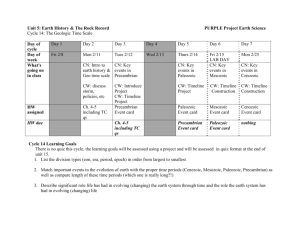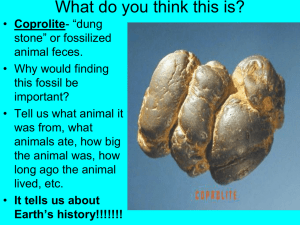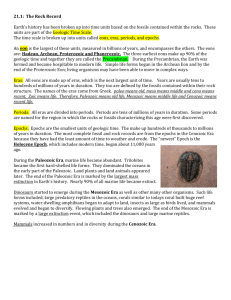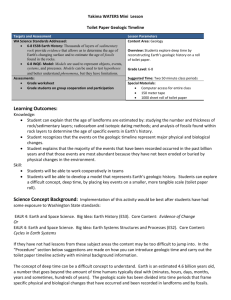PESUnit5GeotimeScaleLabCP12-13
advertisement
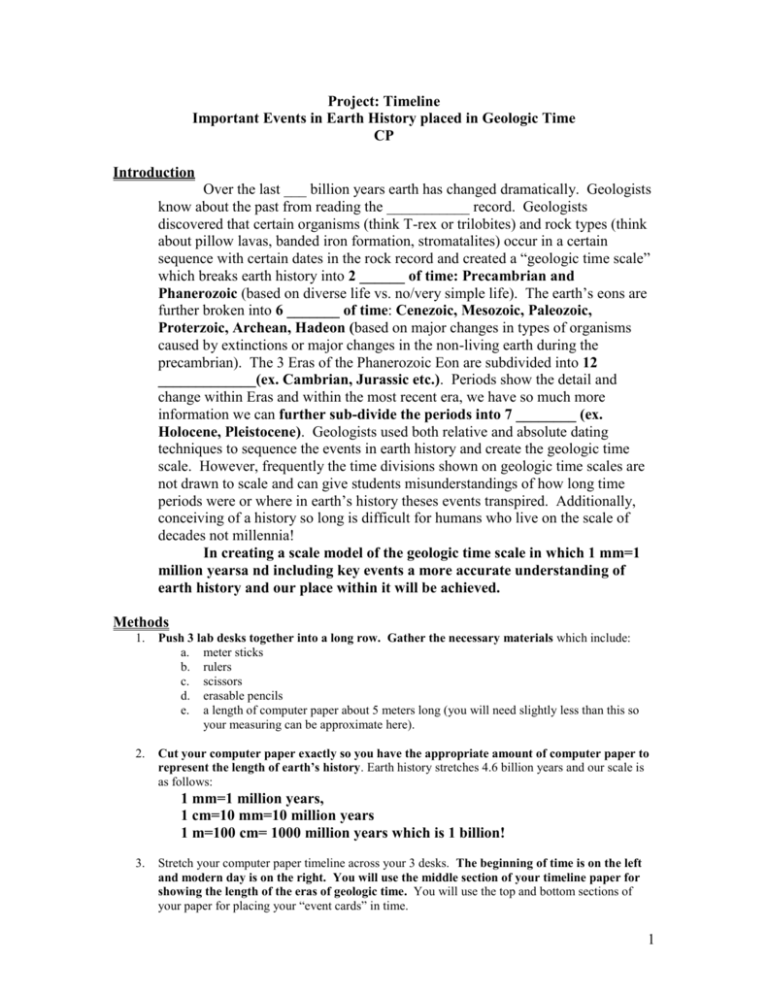
Project: Timeline Important Events in Earth History placed in Geologic Time CP Introduction Over the last ___ billion years earth has changed dramatically. Geologists know about the past from reading the ___________ record. Geologists discovered that certain organisms (think T-rex or trilobites) and rock types (think about pillow lavas, banded iron formation, stromatalites) occur in a certain sequence with certain dates in the rock record and created a “geologic time scale” which breaks earth history into 2 ______ of time: Precambrian and Phanerozoic (based on diverse life vs. no/very simple life). The earth’s eons are further broken into 6 _______ of time: Cenezoic, Mesozoic, Paleozoic, Proterzoic, Archean, Hadeon (based on major changes in types of organisms caused by extinctions or major changes in the non-living earth during the precambrian). The 3 Eras of the Phanerozoic Eon are subdivided into 12 _____________(ex. Cambrian, Jurassic etc.). Periods show the detail and change within Eras and within the most recent era, we have so much more information we can further sub-divide the periods into 7 ________ (ex. Holocene, Pleistocene). Geologists used both relative and absolute dating techniques to sequence the events in earth history and create the geologic time scale. However, frequently the time divisions shown on geologic time scales are not drawn to scale and can give students misunderstandings of how long time periods were or where in earth’s history theses events transpired. Additionally, conceiving of a history so long is difficult for humans who live on the scale of decades not millennia! In creating a scale model of the geologic time scale in which 1 mm=1 million yearsa nd including key events a more accurate understanding of earth history and our place within it will be achieved. Methods 1. Push 3 lab desks together into a long row. Gather the necessary materials which include: a. meter sticks b. rulers c. scissors d. erasable pencils e. a length of computer paper about 5 meters long (you will need slightly less than this so your measuring can be approximate here). 2. Cut your computer paper exactly so you have the appropriate amount of computer paper to represent the length of earth’s history. Earth history stretches 4.6 billion years and our scale is as follows: 1 mm=1 million years, 1 cm=10 mm=10 million years 1 m=100 cm= 1000 million years which is 1 billion! 3. Stretch your computer paper timeline across your 3 desks. The beginning of time is on the left and modern day is on the right. You will use the middle section of your timeline paper for showing the length of the eras of geologic time. You will use the top and bottom sections of your paper for placing your “event cards” in time. 1 4. After drawing a bar down the center of your paper 4.6 m long, you will be subdividing it into Cenezoic, Mesozoic, Paleozoic, and Precambrian time. Use the attached geologic time scale as your guide, noting that all dates are in millions of years before present day and the sections of time are not drawn to scale at all. Use the scale given on the first page of the lab to know how many cm, mm or meters from the right (modern day) each time period begins. Work in erasable pencil first and include: a. Names of each period of time (ex: cenezoic) b. Dates at the boundary between eras 5. Outline each time period in dark sharpie, mark the dates at the boundary of eons, eras, and periods in dark pen in millions of years before modern day, and write the time period names in dark sharpie marker or pen (depending on how small you needed to write). Color each adjacent time period a different color using colored pencils. 6. Each individual in the group should make a minimum of 4 “event cards”, 1 for each era, based on independent research, primarily using the honors textbook. These cards will include a picture which may be printed from a computer or hand drawn in color and a description of the event (typed). Make sure to check spelling, grammar, and make sure your sentences flow logically…this should not be messy notes; the description is written in formal paragraph style, as if it were in a textbook. Put your name and section in the bottom right hand corner of your event cards. 7. Title of Event (when it occurred in years or period/epoch) picture in middle Description of event (typed) below picture Your name, section here Glue or tape event cards to timeline above and below the time in which they occured (make sure to measure from today back in millions of years before present using a meter stick) and use straight black marker arrows to direct us to that location on the timeline. 8. As an option for extra credit, each student may choose to add more individually researched (using the honors textbook as your primary resource) important events to the timeline. TIMELINE PROJECT GRADING RUBRIC NAME: GROUP MEMBERS NAMES: SECTION: Category Advanced Progressing Meets Course Does not Meet 2 Toward Advanced Expectations course Expectations Geologic Time scale construction: scale is accurately used and measurements accurately done so that time divisions are the appropriate length general layout follows all guidelines colorful and neat presentation is visually appealing group is able to choose and assign individual members the most important events of each Era so that the timeline shows all key events. group does not leave any mess and all materials put away each block all parts are well assembled and taped securely with nothing loose Content (individual grade): Event descriptions accurate and descriptive Pictures colorful and neat and give a good visualization/not misleading of what earth was like at that time including representation of key details Event cards properly placed according to scale and date of event/time period All formats followed for event card creation and placement Some Important Events in the Evolution of the Earth Precambrian Events 4.6 billion years ago-543 million years ago 1. Liquidification, differentiation (Hadean era) and outgassing 2. Early volcanically produced atmosphere (Hadean era-archaen) 3. Heavy bombardment, second liquidification, and moon formation (Hadean) 4. Oldest known solid earth rock (marks beginning of Archaen-3.8) 5. Great rains and oceans form (Archaen) 6. First life-bacteria also known as prokyriotes (Archean 3.5) 3 7. Oxygen pollution of atmosphere begins increasing rapidly from 1% to 15% (2.2 billion years to 1.8 billion years end of archean beginning of proterozoic) 8. stable continents begin to appear (marks beginning of proterozoic 2.5 bya) 9. Stromatelite forming bacteria peak 10. first eukeriotic ancestors (of plants, animals) (proterozoic 1.8) 11. oxygen build-up (proterozoic-end) 12. first true animals form (proterozoic-end) Paleozoic Events 1. Cambrian explosion (lots of diverse organisms form in short amount of time including the first organisms with hard parts (Cambrian 543mya) like trilobites 2. Break up of first super-continent “Rodinia” (Cambrian) 3. Gondwana supercontinent located at south pole (Ordovician) as a result lots of ice formed and sea levels fell 4. First land plants (ordovican) 5. First land animals (Silurian) 6. melting of glacial ice, increased sea level, and first stabilization of climate (silurian) 7. Jawless fish dominant, first jawed fish, first freshwater fish (Silurian) 8. First trees and seed plants (Devonian) 9. crinoids and other echinoderms as well as rugose corals and ammonites common in seas (Devonian) 10. first terrestrial arthropods (insects etc.) (Devonian) 11. Appalachian & Ural mountains are formed (Carboniferous) 12. modern conifers begin to take over from fern trees (Permian) 13. Pangea forms (Permian) 14. permo-triassic extinction=largest extinction know=90% of ocean life wiped out (end of Permianboundary between Cenezoic and mesozoic) Mesozoic Events 1. first dinosaurs (Triassic) 2. First mammals (Triassic) 3. herbivore dinosaurs dominate feeding on fern forests…small carnivore dinosaurs (Jurassic) 4. first birds (Jurassic) 5. break-up of pangea (began in Jurassic, continues in Cretaceous) 6. K/T extinction (end of Cretaceous) caused by meteorite hit Cenezoic Events 1. expolosion in mammel evolution, largest land animals are now mammels (Paleocene) 2. modern grasslands and grazing mammals (Miocene, Pliocene) 3. recent ice age (Pleistocene) at end of which mammoths, & sabor-toothed cats went extinct 4. evolution of homosapians (Pleistocene) (perhaps causing the extinction of the large Pleistocene mammals like the mammoths) 5. modern civilizations (holocene) 6. anthropogenic (human caused) changes to the earth system such as ozone hole (holocene) and extinction of species and change in climate 4




